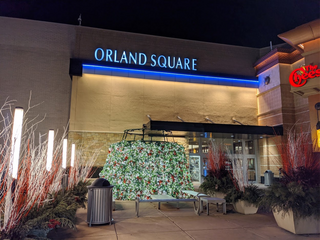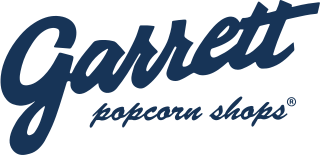
The May Department Stores Company was an American department store holding company, formerly headquartered in downtown St. Louis, Missouri. It was founded in Leadville, Colorado, by David May in 1877, moving to St. Louis in 1905. After many changes in the retail industry, the company merged with Federated Department Stores in 2005.

Macy's, Inc. is an American conglomerate holding company. Upon its establishment, Federated held ownership of the regional department store chains Abraham & Straus, Lazarus, Filene's, and Shillito's. Bloomingdale's joined Federated Department Stores the following year. Throughout its early history, frequent acquisitions and divestitures saw the company operate a number of nameplates. In 1994, Federated took over the department store chain Macy's. With the acquisition of The May Department Stores Company in 2005, the regional nameplates were retired and replaced by the Macy's and Bloomingdale's brands nationwide by 2006. Ultimately, Federated itself was renamed Macy's, Inc. in 2007.

Macy's is an American chain of high-end department stores founded in 1858 by Rowland Hussey Macy. It became a division of the Cincinnati-based Federated Department Stores in 1994, through which it is affiliated with the Bloomingdale's department store chain; the holding company was renamed Macy's, Inc. in 2007. As of 2015, Macy's was the largest U.S. department store company by retail sales.
Marshall Field & Company was an upscale department store in Chicago, Illinois. Founded in the 19th century, it grew to become a large chain before Macy's, Inc acquired it in 2005. Its eponymous founder, Marshall Field, was a pioneering retail magnate.
Foley's was a chain of department stores owned by May Department Stores and headquartered in Downtown Houston, Texas. On August 30, 2005, the division was dissolved and operation of the stores was assumed by Federated's Macy's West and Macy's South divisions. Foley's operated stores in Texas, Colorado, Louisiana, Arizona, Oklahoma and New Mexico. On September 9, 2006 Foley's and all the regional May Co. stores names were phased out and rebranded as Macy's.

Frederick & Nelson was a department store chain in the northwestern United States, based in Seattle, Washington. Founded in 1891 as a furniture store, it later expanded to sell other types of merchandise. The company was acquired by Marshall Field & Company in 1929. By 1980, the Frederick & Nelson chain had expanded to 10 stores in two states. The company went out of business in 1992. Its former Seattle flagship store building is now occupied by the flagship Nordstrom store.

The Bon Marché, whose French name translates to "the good market" or "the good deal", was a department store chain launched in Seattle, Washington, United States, in 1890 by Edward Nordhoff. The name was influenced by Le Bon Marché, the noted Parisian retailer.

Filene's was an American department store chain; it was founded by William Filene in 1881. The success of the original full-line store in Boston, Massachusetts, was supplemented by the foundation of its off-price sister store Filene's Basement in 1908. Filene's, in partnership with Abraham & Straus, Lazarus, and Shillito's, was an original member of the holding company Federated Department Stores upon its establishment in 1929.

British American Tobacco US, mostly known for its acronym BATUS, was the US subsidiary of multinational company British American Tobacco (BAT), the world's second largest cigarette manufacturer. BATUS served as the U.S. holding company for BAT. In the 1960s, the company diversified into areas such as insurance, drink and the apparently booming world of retail.
Fannie May Confection Brands, Inc. is an American chocolate manufacturer headquartered in Chicago and currently owned by Italian company Ferrero SpA. Fannie May manufactures a broad variety of products including enrobed, barks, caramels, squares, berries, twist wrapped, molded, flow wrapped, and boxed chocolates. In attempt to reach all consumers, Fannie May became allergy conscious carrying candy without gluten, milk, honey, oil(s), wheat, eggs, etc. The Union of Orthodox Jewish Congregations of America certified many of Fannie May's products to be kosher as well.
Allied Stores was a department store chain in the United States. It was founded in the 1930s as part of a general consolidation in the retail sector by B. E. Puckett. See also Associated Dry Goods. It was the successor to Hahn's Department Stores, a holding company founded in 1928. In 1935 Hahn's was reorganized into Allied Stores.

Fashion Fair is a medium-sized, enclosed shopping mall in Fresno, California, anchored by two Macy's stores, JCPenney, and Forever 21. Originally opened in 1970, Fashion Fair was expanded in 1983 and in 2005. It competes with The Shops at River Park and Fig Garden Village, two outdoor shopping centers in the city of Fresno.

North Star Mall is a shopping mall in San Antonio, Texas, USA with anchor tenants Dillard's, JCPenney, Macy's, Saks Fifth Avenue, and Forever 21. The mall also has over 200 specialty stores, some exclusive to the San Antonio market, including Armani Exchange, The Cheesecake Factory, Build-A-Bear Workshop, MAC Cosmetics, and Oakley. The mall, which opened in 1960, is located at the intersection of Loop 410 and San Pedro Avenue in the city's Uptown District. It is a well-known city landmark for its Texas-sized cowboy boots, created by Texas artist Bob "Daddy-O" Wade, that are located along its Loop 410 frontage.

Orland Square is a shopping mall located in Orland Park, Illinois. It is the largest mall in the Chicago Southland, the south and southwest suburbs of Chicago, covering an area of 1,229,884 square feet. It opened on March 15, 1976 and received major renovations in 1995. Its anchor stores are JCPenney, Macy's and Von Maur. It also has two restaurants, Cheesecake Factory and Texas de Brazil.

The Crescent was a small chain of department stores founded and based in Spokane, Washington. Once a subsidiary of Marshall Field & Company, the chain was sold to BATUS Retail Group in 1982. BATUS renamed the stores Frederick & Nelson, the company's Seattle, Washington division, in 1988. Frederick and Nelson eventually filed for bankruptcy and liquidated in 1992. At its peak, The Crescent operated seven department stores in Washington and Oregon, including three in Spokane.

The Marshall Field and Company Building, which now houses Macy's State Street in Chicago, Illinois, was built in two stages—north end in 1901–02 and south end in 1905–06, and was the flagship location of the Marshall Field and Company and Marshall Field's chain of department stores. Since 2006, it is the main Chicago mid-western location of the Macy's department stores. The building is located in the Chicago "Loop" area of the downtown central business district in Cook County, Illinois, U.S.A., and it takes up the entire city block bounded clockwise from the west by North State Street, East Randolph Street, North Wabash Avenue, and East Washington Street.

Patchi is a chocolatier based in Lebanon. Established by Nizar Choucair in 1974, it is distributed across much of the Middle East, and they sell chocolate internationally as well.

There have been more than 300 limited-edition seasonal and regional flavors of Kit Kat chocolate bars produced in Japan since 2000, many exclusive to the country and not produced elsewhere. Nestlé, which operates the Kit Kat brand in Japan, reports that the brand overtook Meiji Chocolate as the top-selling confectionery in Japan from 2012 to 2014. The company's marketing campaign, which partnered with Japan Post to sell the bar in 20,000 post offices, won an award in 2010. The campaign encouraged associations of the product's name with the coincidental cognate Kitto Katsu (きっと勝つ), translated as "You will surely win", and could be mailed as a good luck charm for students ahead of university exams.
Gertrude Jones Hawk (1903-1987) was an American candy maker and entrepreneur who created the Gertrude Hawk Chocolates company based upon her experience making chocolate from her home in Scranton, Pennsylvania. Gertrude Hawk was central to the company's financial success due to her development of fundraising networks in which local civic institutions could resell chocolates to support their own programs.

Garrett Popcorn Shops is an American chain of gourmet popcorn stores founded in 1949 in Chicago, Illinois. Today, it has shops in nine countries, corporate offices in Chicago, Singapore, and Tokyo, and an online store. The majority of its brick and mortar stores are still in Chicago, including shops on the Magnificent Mile and in the O'Hare International Airport. As such, it is often referenced as part of classic Chicago cuisine.

















